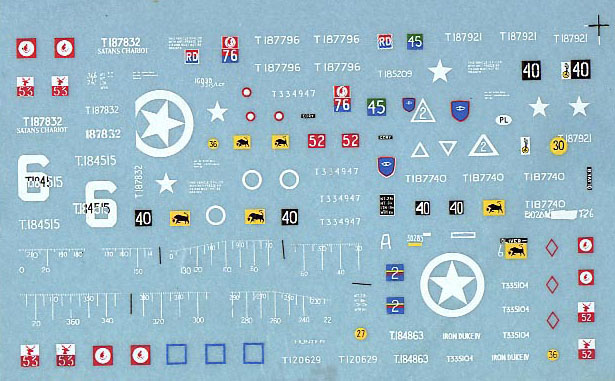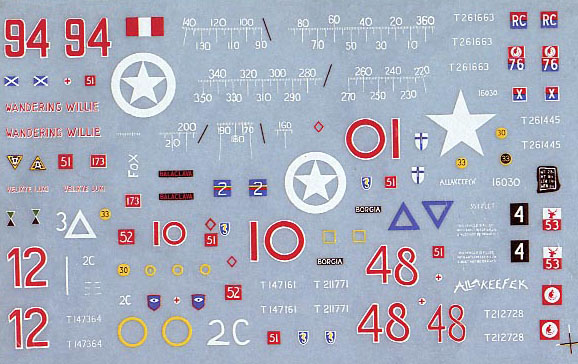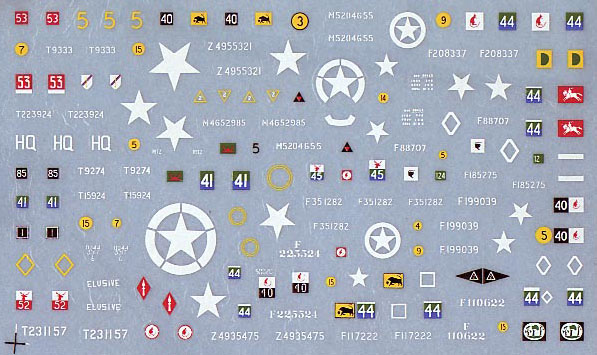Bison British Armour decal sheets
(1/76 & 1/72, NW Europe 1944-45)
by Peter Brown
Years ago I cut my modelling teeth on small-scale kits,
building many Airfix Shermans, Churchills etc, various Matchbox models
and even trying my hand at conversions and scratch-building. At the time
they were all that was available, and aftermarket items were all-but unknown
apart from some vac-form items and only a few limited run decal sheets
- we old-timers called them "transfers". Then along came 1/35th
tanks and the emphasis moved on, taking many including me with them.
As fashions change in clothing so they do in modelling,
and in recent times new AFV kits in 1/76 and 1/72 have appeared alongside
re-released old timers (some of which rival me in age). To support these
we have add-on items and these new sets of decals from Bison will be welcomed
by those who model in "braille scale" and doubly so as they
cover British subjects.
I have received four sets for review: these provide complete
sets of markings from serials and white stars to division and arm of service
signs for several vehicles grouped in themes. These are based on photos
and the references used are quoted in the instructions which makes life
easier for those who want to get the correct appearance of the original
vehicles as several will need some conversion to make accurate replicas
though the line drawings showing decal placement are good guides to the
changes needed.
These are described as for 1/76 and 1/72, in some cases
models will be available in one or other scale and maybe both and the
difference in this scale is not great. All cover subjects in the NW Europe
1944-45 campaign. Sources for the markings are listed, and wisely the
designers suggest referring to photos. I spotted a few areas I was not
happy with which I will mention as I go along. Please take these as clearing
up what may be printing errors, not criticism of the designer's research,
which looks very good.

BD-72004 (shown above) covers Centaur, Cromwell and Comet
tanks. Matchbox's Comet had some nice decals with their kit and this set
gives two options, the one for 1RTR tank is post-war - 7th Armoured Division
did not re-equip with Comet until after VE-Day - and we get sets for two
Centaurs, one 6-pounder armed tank used for trials and the well-known
HUNTER of the Royal Marines Armoured Support Group complete with the turret
traverse markings, which would be hard to depict without a decal. The
remaining seven subjects cover Cromwells of various units, one set is
for General Maczek's command tank in 1st Polish Armoured Division, another
replaces the Revell kit markings for a 5th RHA tank as at Villers Bocage
while one more is for an Armoured Recovery Vehicle.

BD-72005 (shown above) deals with a range of what could
be called artillery vehicles. Ten subjects are covered; three M10 (named
"Wolferine" and "Achilles") with one 3"-armed
vehicle used on D Day and two 17-pounder ones serving with Corps-level
Anti-Tank Regiments; two 17pdr SP Valentine otherwise known as Archer
serving with different Infantry Divisions and what is strictly speaking
a tank, an A30 Challenger with 8th Kings Royal Irish Hussars; two Crusader
AA tanks, one from a well-known shot with the vehicle still carrying its
wading trunking and another serving as a OP or "Officer's Charger"
with the Royal Artillery; and last but not least are two 25pdr SP Ram
or Sexton, the one for the Essex Yeomanry even has the divisional sign
in two parts for greater accuracy.

BD-72006 (shown above) is headlined as Firefly Vc but covers
a wide range of Shermans, a DD and a wading tank from 13/18 Hussars on
D Day, a Crab Flail, three Fireflies including one of Wittmann's victims
at Villers Bocage and the Vc which ended his career and a composite-hull
version with 60-lb rockets. We also get three Observation Post tanks,
the one for the Royal Marines Armoured Support Group comes complete with
the traverse markings for the turret was a Sherman V not an M4A1, another
is another Wittmann victim and finally an Essex Yeomanry tank.

BD-72007 (shown above) covers the widest range with markings for no less
than 17 vehicles. These include three from the 6th Airborne Armoured Reconnaissance
Regiment, two Tetrarches of the type flown in on D Day and a T.9 Locust
from the 1945 Rhine crossings; and two Stuarts, a V from 5RTR just after
D Day and a VI from 1945. The other subjects are all wheeled, an AEC Mk
III, two Daimler Armoured Cars - the 11th Hussars car was a Mk II version
on a post-war parade in Berlin - and a Dingo, two Humber Scout Cars, one
Humber and one Morris Light Reconnaissance Cars, two Staghounds and two
White Scout cars with a range of markings for Divisional and Corps units.
Overall the quality of the decals looks good, with several
less than obvious choices of subject alongside some well-known vehicles.
Apart from some minor issues as recorded above and a slight q
uibble on
the shape of Guards Armoured Division signs these appear accurate. Though
they depict specific subjects many items could be adapted for other vehicles,
and some sets fit naturally with others with different vehicles for the
same unit or location which will be useful for dioramas and themed collections.
As to availability of kits for these – well, I am
not well up in this area but a visit to the model shop or online retailers
will no doubt turn up many suitable items.
More details can be found on www.angelfire.com/pro/bison
– I think these sets will be good sellers and certainly hope they
become so. Maybe they will inspire a new generation of modellers to try
small scale AFVs or even tempt others back?
Peter Brown, 22 February 2004
|